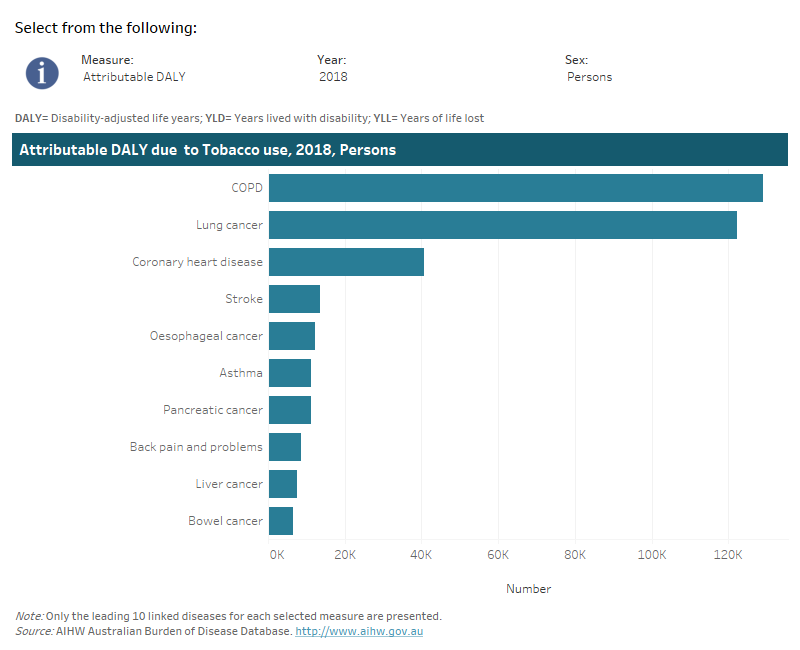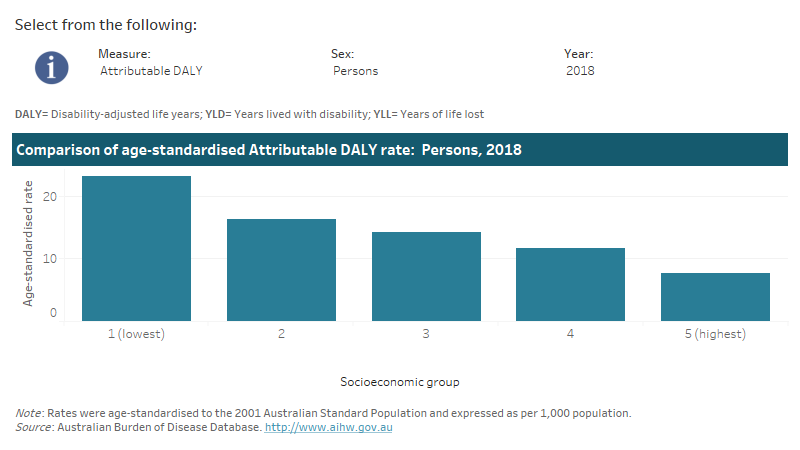Tobacco use
In 2018, 8.6% of the total disease burden in Australia was due to tobacco use, making it the leading risk factor that contributed to disease burden and deaths.
These estimates reflect the amount of disease burden that could have been avoided if all people in Australia had not used tobacco or been exposed to second hand smoke in their lifetime.
Tobacco use was causally linked to the burden of 41 individual diseases including: 19 types of cancer; 7 cardiovascular diseases; chronic obstructive pulmonary disease (COPD); and asthma (see ABDS 2018 Risk factor estimates data table).
How much burden was attributable to tobacco use?
Tobacco use was responsible for over 76% of the total disease burden due to lung cancer, 73% of the burden due to COPD and over 50% of the burden from oesophageal cancer.
Tobacco use contributed the most to fatal burden, with almost 20,500 deaths (13% of all deaths) in 2018.
Note that the following visualisation displays the top 10 linked diseases due to tobacco use by the selected measure.
This interactive data visualisation shows the burden attributable to tobacco use by linked disease. The main section shows a horizontal bar graph which can be customised to report data according to year, sex and measure of attributable burden. Each bar represents the attributable burden of the disease linked to tobacco use.

How did burden attributable to tobacco use vary by age and sex?
Tobacco use contributed to total disease burden across all age groups, including infants and young children exposed to second hand smoke. Most of the tobacco use attributable burden was experienced in both males and females aged 45 and over.
Males experienced a greater amount of burden attributable to tobacco use compared with females in all ages up to 84 years, after which it was higher in females. In 2018, the largest number of deaths (4,531) occurred in the 65–84 age group.
This interactive data visualisation shows the amount of burden attributable to tobacco use by age group and linked disease. The main section shows a stacked bar graph which can be customised to report data according to year, sex, disease group and measure of attributable burden. Each bar represents the attributable burden within a particular age group. Each bar is also split into separate components with each colour representing a disease linked to tobacco use.

This interactive data visualisation shows the rate of burden attributable to tobacco use by socioeconomic group. The main section shows a bar graph which can be customised to report data according to year, sex and measure of attributable burden. Each bar represents the attributable burden within a particular socioeconomic group due to tobacco use.

How has disease burden attributable to tobacco use changed over time?
The rate of total burden attributable to tobacco use (from all linked diseases) decreased by 32% between 2003 and 2018 (from 21.5 DALY to 14.6 DALY per 1,000 population). The rate of deaths associated with tobacco use decreased by 31% between 2003 and 2018 (from 1.0 to 0.7 deaths per 1,000 population).
This interactive data visualisation shows the rate of burden attributable to tobacco use by year. The main section shows a horizontal bar graph which can be customised to report data according to year, sex and measure of attributable burden. Each bar represents the attributable burden within a particular year due to tobacco use.



